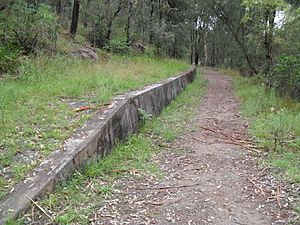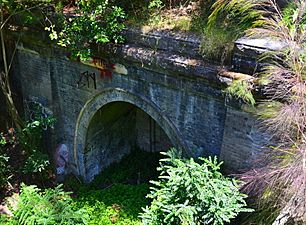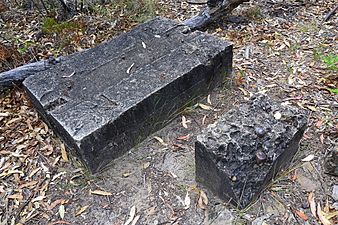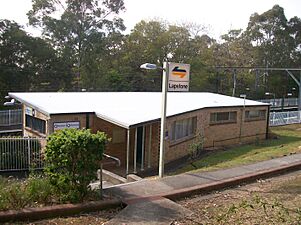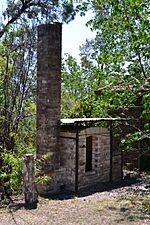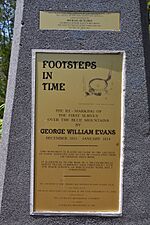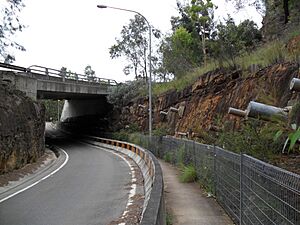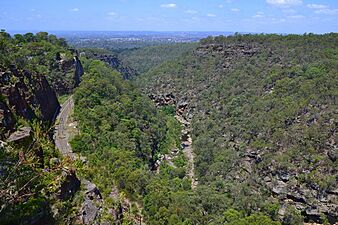Lapstone, New South Wales facts for kids
Quick facts for kids LapstoneBlue Mountains, New South Wales |
|||||||||||||||
|---|---|---|---|---|---|---|---|---|---|---|---|---|---|---|---|
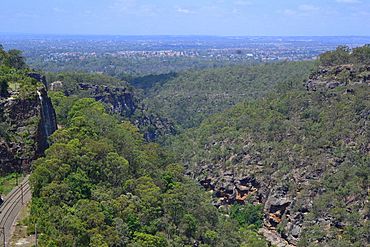
View east from south Lapstone
|
|||||||||||||||
| Population | 961 (2016 census) | ||||||||||||||
| Postcode(s) | 2773 | ||||||||||||||
| Elevation | 160 m (525 ft) | ||||||||||||||
| Location |
|
||||||||||||||
| LGA(s) | City of Blue Mountains | ||||||||||||||
| State electorate(s) |
|
||||||||||||||
| Federal Division(s) | Macquarie | ||||||||||||||
|
|||||||||||||||
Lapstone is a small town in the Blue Mountains in New South Wales, Australia. It sits on the eastern edge of the mountains, about 160 meters (525 feet) above sea level. Lapstone is located 62 kilometers west of Sydney city center. It is part of the City of Blue Mountains area.
Lapstone is known for its houses and a few public places. In 2016, about 961 people lived here. The town's name comes from the many smooth, water-worn stones found in the area. These stones look like the ones shoemakers used to shape leather. Lapstone was first bought and developed by Mr. Arthur J. Hand.
Contents
A Look Back: Lapstone's History
Lapstone has a rich history, especially with how people traveled through the Blue Mountains.
Early Explorers and Roads
In 1813, Blaxland, Lawson, and Wentworth were the first Europeans to explore the Lapstone area. They climbed Lapstone Hill on May 12, 1813. This was part of their successful journey across the Great Dividing Range.
The first road was built around 1815 by William Cox and a group of convicts. This road went up Lapstone Hill and across the Blue Mountains. You can still see a plaque for this old Cox Road near the M4 junction. Later, "The Western Road" was built in 1833. It went over the Lennox Stone Bridge and up Lapstone Hill. After the railway came in 1867, "The Great Western Highway" became the main road. Today, this highway is still the main way to travel up Lapstone Hill and across the Blue Mountains.
The Lapstone Zig Zag Railway
The Lapstone Zig Zag railway line opened in 1867. It was also called the "little" zig zag. This railway helped trains climb Lapstone Hill, which was very steep. It had a special design to make the climb easier.
A big part of this railway was the seven-span sandstone Knapsack Viaduct. This bridge was later made wider to carry the old Great Western Highway. Today, the zig zag is a walking trail. It includes a memorial to John Whitton, who was the engineer for the Blue Mountains railway line. You can still see parts of the Lucasville platform, which was built for John Lucas to reach his property.
The Lapstone Tunnel (1892)

A new railway route opened on December 18, 1892. This new route avoided the Lapstone Zig Zag. After crossing the viaduct, the line went through a new tunnel called the Lapstone Tunnel. This tunnel was 660 meters long. You can still see it from nearby bush tracks.
The new tunnel was a big improvement. However, it had problems with air flow and water from a nearby creek. Trains sometimes got stuck inside. Because of these issues, the Lapstone Tunnel was closed on September 24, 1913.
During World War II, the abandoned Lapstone Tunnel was used by the nearby RAAF base. They stored weapons like bombs and mustard gas there. The RAAF even put a concrete floor in the tunnel for better storage. It has also been used to grow mushrooms!
The Glenbrook Tunnel (1913)
In 1913, a new railway route was built to bypass the Lapstone Tunnel. This route went along the edge of Glenbrook Gorge and through a new tunnel at a spot called The Bluff. For this project, a temporary railway line was built. This line crossed Darks Common.
The temporary railway line has been removed, but you can still see the cutting where it ran. You can also see the remains of the winding house base. This temporary line was called the Spur-line. It was used from 1911 to 1913. Today, the line and cutting are part of a nature walk through Darks Common. The Glenbrook Tunnel, which is 282 meters long, opened on May 11, 1913. It is still used by trains today.
The Lapstone Hill Hotel
The land where the RAAF base is now was once owned by John Lucas in the 1870s. He built a country house called Lucasville there. Later, Charles Smith bought the property and built his own house, Logie.
In 1921, Herwold Kirkpatrick bought Logie and its land. Kirkpatrick was an architect. In the late 1920s, he started to turn Logie into a fancy hotel.
The Lapstone Hill Hotel opened in 1930. It was a grand Art Deco luxury hotel. Its large grounds had beautiful lawns and gardens. The hotel offered amazing views of the Nepean River and even glimpses of Sydney. It was very popular in the 1930s. The hotel was known for promoting the health benefits of the mountain air. Many people from Sydney came to escape city life.
In 1949, the Lapstone Hill Hotel became the headquarters for the RAAF’s Eastern Area Command. This is now known as the RAAF Base Glenbrook. For many years, no one lived in the hotel's 57 rooms. But in 1982, it became the Officers’ Mess. About 35 officers lived on the upper floor. Special suites downstairs are used for important visitors.
The New Lapstone Hotel
After the RAAF bought the Lapstone Hill Hotel, a new hotel was built in the 1950s. This hotel was located further up the Great Western Highway in Blaxland. It was called "The New Lapstone Hotel" until the 1980s.
Today, this hotel is known simply as The Lapstone Hotel. It was updated in 2007 after a new company bought it.
Housing Development
The suburb of Lapstone was developed in the 1960s. Mr. Arthur J. Hand bought the land to create the new housing area. The Lapstone railway station opened in 1964 to serve the people living in these new homes.
Darks Common Reserve
Darks Common became a public reserve in the 1970s. This was done to stop more houses from being built there. A local person named Micheal Dark was a strong voice for protecting the area. The reserve is named after his family.
There are many walking tracks in Darks Common. The Spur-Line walking track leads to the Glenbrook Creek. From Bluff lookout, you can see great views of Glenbrook Gorge. Lapstone Oval is also located inside Darks Common.
Who Lives in Lapstone?
In the 2016 Census, there were 961 people living in Lapstone. Most people (81.0%) were born in Australia. Also, 87.7% of people spoke only English at home. For religion, the most common answers were No Religion (30.0%), Catholic (24.9%), and Anglican (18.9%).
Images for kids
Getting Around Lapstone
Public Transport Options
Lapstone railway station is part of the NSW TrainLink network. It is on the Blue Mountains Line. This means you can travel by train to and from Lapstone. The station was built by R&K McGraw Builders. It officially opened on February 24, 1964.
You can also reach Lapstone by car. Take the Great Western Highway/M4 Motorway and exit at Governors Drive and Explorers Road from Glenbrook. Buses also serve the area, making it easy to get around.
Learning in Lapstone
Lapstone Public School
Lapstone Public School opened in 1971. A local resident, Jean Ranft (later Jean Jones), worked hard to get money for the school. She even helped with some of the building work herself! The Ranft family and other community members also helped. Jean is shown with the first class in 1971. You can see the bushland growing back after the big bushfires in 1968.
Sports and Fun in Lapstone
Netball Courts
The Lapstone Netball Courts are home to the Lapstone Glenbrook Netball Club. There are 9 asphalt courts and 2 grass courts. The complex also has a clubhouse and a BBQ area. All clubs in the Blue Mountains Netball Association play matches here on Saturdays. Netball is the most popular sport in the Blue Mountains.
The Lapstone Glenbrook Netball Club started in 1975. It was formed by joining St Peter's Netball Club with school teams from Lapstone Public School and Glenbrook Public School.
Lapstone Oval Sports
Lapstone Oval is where the Blue Mountains District Rugby Football Club plays. Their junior club, Blue Tongues Rugby, also plays here. The oval has a Rugby Union field and an artificial cricket pitch.
The Glenbrook/Blaxland Cricket Club plays matches on the oval during the summer. There are also 2 tennis courts at Lapstone Oval and a children's play area.



